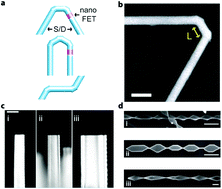Nanoscale silicon for subcellular biointerfaces
Abstract
Semiconductor nanomaterials are emerging as a class of materials that can push the fundamental limits of current biomedical devices and possibly revolutionize healthcare. In particular, silicon nanostructures have been proven to be attractive systems for integrating nanoscale machines in biology because of their tunable electronic and optical properties, low cytotoxicity, and the vast microfabrication toolbox available for silicon. Studies have demonstrated that the implementation of next-generation silicon-based biomedical devices can benefit from the rational design of their nanoscale components. In this review, we will discuss some recent progress in this area, with a particular focus on the chemical synthesis of new silicon nanostructures and their emerging applications ranging from fundamental biophysical studies to clinical relevance.

- This article is part of the themed collections: Recent Review Articles and Journal of Materials Chemistry B Emerging Investigators

 Please wait while we load your content...
Please wait while we load your content...